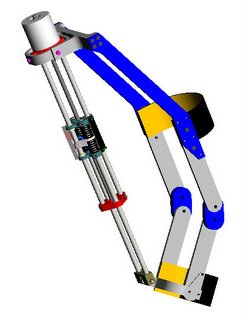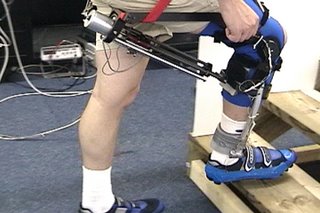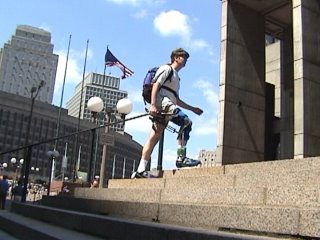 RoboWalker is one of the main projects in the area of legged robots and powered leg orthotics that Yobotics, a cutting-edge robotic design, consulting, and research firm specializing in biomimetic robots, powered leg orthotics and force-controllable actuators, is currently engaging in. The main aim of the RoboWalker is to assist people suffering from weakness in lower extremities by augmenting or replacing muscular functions of the lower extremities. Possible causes of such disabilities come in many forms, including stroke, post-polio syndrome, multiple sclerosis and muscular dystrophy.
RoboWalker is one of the main projects in the area of legged robots and powered leg orthotics that Yobotics, a cutting-edge robotic design, consulting, and research firm specializing in biomimetic robots, powered leg orthotics and force-controllable actuators, is currently engaging in. The main aim of the RoboWalker is to assist people suffering from weakness in lower extremities by augmenting or replacing muscular functions of the lower extremities. Possible causes of such disabilities come in many forms, including stroke, post-polio syndrome, multiple sclerosis and muscular dystrophy.

A power-assisted wearable device that could provide the leg strength, support and endurance for the elderly and those with effects of lower limbs weakening diseases, RoboWalker, if successfully developed, would be a state-of-the-art breakthrough in orthotic device, which currently consists of only passive device. RoboWalker webs the leg and foot in a series of artificial, exoskeleton springy tendons and muscles. The device is able to, through the numerous sensors, know exactly the user’s next course of action, and provides bursts of muscular energy through the brace when needed. Such burst of energy provides the necessary strength that could assist the user in accomplishing the task (for instance walking up the stairs or even standing up from sitting position) which he or she may otherwise have difficulty accomplishing. Nevertheless, just like its scaled-down cousins RoboKnee or RoboAnkle, RoboWalker is not useful for paraplegics (complete paralysis of the lower extremities), since the user must have the ability to first put the leg where it needs to go in order for RoboWalker to provide the necessary assistance to complete the motion.
While the RoboWalker prototype has had rather impressive trial results, there are also certain drawbacks associated with it. Firstly, the batteries that power the device can only last for a relatively short period of use. Recharging the batteries or changing a new set would be required after about 30 to 40 minutes of wireless assisted walking. Secondly, while the final price of the actual device is unknown, the estimated cost in the range of $10,000 may make it prohibitively expensive for most people.
 The success of RoboWalker will see the change in lives of many disabled and elderly people. It will definitely replace the wheelchair as the preferred means of locomotion for these people. Not only will this innovation greatly reduce the inconvenience brought to people suffering from weakness in lower extremities, such breakthrough in technology would also bring about a huge cost savings to social welfare system, where the needs for modifications to improve mobility (wheelchair-friendly houses, stair lifts, car lifts, home aids etc) would be reduced.
The success of RoboWalker will see the change in lives of many disabled and elderly people. It will definitely replace the wheelchair as the preferred means of locomotion for these people. Not only will this innovation greatly reduce the inconvenience brought to people suffering from weakness in lower extremities, such breakthrough in technology would also bring about a huge cost savings to social welfare system, where the needs for modifications to improve mobility (wheelchair-friendly houses, stair lifts, car lifts, home aids etc) would be reduced.
Links:
http://yobotics.com/robowalker/robowalker.html
http://www.roboticstrends.com/displayarticle35.html?POSTNUKESID=a8fd9114cf249d6866513b067b7a5f8f
14 comments:
u0204781 Peh Meng Wee
The robowalker is a great invention, especially if it can let disbled people walk again. It would give them a new lease of life. However, I think that it is a little bulky and it would be good if it is made to be more fitting.
u0300510 Chen Yanchang
It's wonderful that the lame can walk again albiet assisted by the use of technology. This a great example of how robotics can be used to help mankind.
However, I this notion of an muscular augmentation can also be used to the deteriment as well. An example will be to utilize for the military in wars. Although one can also argue that it can be used for defence as well.
I refering to the development of exoskeletons not unlike Sigourney Weaver in Aliens, by the US Defense Advanced Research Projects Agency (DARPA). This is a US$50 million project known as "Exoskeletons for Human Performance Augmentation".
The project aims to develop real-time controlled exoskeletons that not only increase strength and speed, but also allows larger weapons to be carried and provide a higher level of protection from enemy fire or chemical attack. It should also allow wearers to stay active longer and carry more food, ammunition and field supplies. Finally, the intention is for exoskeletons to even be programmed to bring injured soldiers back to base by themselves.
Thus, not just the weak becoming stronger but the strong becoming more powerful.
Reference:
http://www.gizmag.co.uk/go/1604/
u0204569 Tan Wen Pin
As mentioned in the blog, the robot can only last 40 mins per battery charged. This serves to be a major downside to a practical situation. It is unlikely that the person will only walk 40 mins when he goes out of the house. If the battery runs out when he is outside, he might be in a fix. Alternatively, he can bring extra batteries around. But this will add on weight and high costs.
U0204840 Lin Ming Zheng
Though this is a great invention, I do hope that further research can be done to improve the power consumption (it can only last 40 minutes now) and the total cost (about 10k). If these 2 areas can be improved on, this will certainly benefit more people.
u0204779 Pang Sze Yong
Technology is a double edged sword and while the advantages of the robowalker have been clearly illustrated in the post, the other edge of the sword is not shown.
Just like Chen Yanchang mentioned, such an invention could be the beginning of cybernatically enhanced soldiers. It would be the beginning of wars that are even more devastating and cruel. But given the limitations of portable power, such a worry is still science fiction.
Another point I would like to make is that while numerous advances have been made in robotics, communications, data storage, personnal entertainment etc etc, our technology of providing portable power has not kept up with all our other developments. If some breakthrough in portable power is made, many of the other technologies will benefit greatly and no longer have to work around the previous limitations of power consumption.
u0204699 Ong Chin Soon
It is no doubt that such an invention may ultimately be engaged for military purposes. Nevertheless, I believe this should not be the reason for stifling the creativity of humankind to produce useful devices, especially if these creations could give many people a new lease of life. While wars can be more devastating, initiators of wars would also be more careful about and might be deterred from launching a war, given the amount of destructions these wars may now bring about to themselves.
I agree with Sze Yong that research on portable power seems relatively subdued. Portable power is indeed hard to develop, especially if light weight is main concern. Nevertheless, there have been researches on the use of thermoelectric materials that exploit the temperature gradient between human body and the surrounding to produce electricity for driving simple device. The human body is a huge heat sink and if an efficient means can exist to tap the metabolic heat energy and convert it into electrical current, portable energy would be limitless. Of course, Carnot efficiency has placed an upper limit on how efficient wasted heat can be harnessed into useful energy. In any case, unless there is an immense breakthrough in research, it would be hard for these thermoelectric materials to produce power sufficient to drive many loads.
U0205332 Yang Shaohua
I feel there are some kinds of safety issues on this robots.If, if such RoboWalker 'become' unstable,maybe due to the wrong operations, power problem, or unexpected situation, or someother reason, it definitely will hurt the ppl using it.
U0308279 Chan Hwa Huei
The robowalker does allow a disalbed person to walk normally. However due to its short battery life , it is unlikely to replace wheelchairs and crutches in the near future. However, it serves as an excellent rehabilitation tool. Patients, who had just completed an operation to their lower limbs, usually have to go through a long rehabilitation to regain the strength in their legs. However, robowalker can be used to cut short the amount of rehab time needed, since patients could immediately practice walking soon after their operation.
U0204734
Woo Handa Raymond
It can be seen the power issue of this Robowalker is the main drawback. It only can last 40 minutes before it is needed to recharge again. Thus, it can serve as mean of very inconvenience especially for the elders.
Thus, the issue of portable power has been highlighted, it is true that there is not so much progress on that. If this problem can be solved, there might be a breakthrought in this kind of robowalk technology provided that the weight of portable power is not so heavy otherwise it may defeat the purpose of this robowalker to assist people in walking.
U0205319 Tuo Xiane
Recently a similar invention has been made in New York which was reported in the news a few days ago. Please see the pictures on the following website to have a better idea about this invention.
http://www.hhdt.net.cn/Get/shengming/153715134.htm
This invention is also a robotwalker, but it is more fitting and tidy.
Thanks for sharing information.
Robots and Device Solutions
Thanks for sharing nice blog about Robots and device solutions.
Crafsol Technology is the worlds largest provider of Robots and Device Solutions that interconnect robots revolutionary in accelerating systems, low cost and high efficiency program to connect Robots and Device solutions.
Robots and Device Solutions
Post a Comment